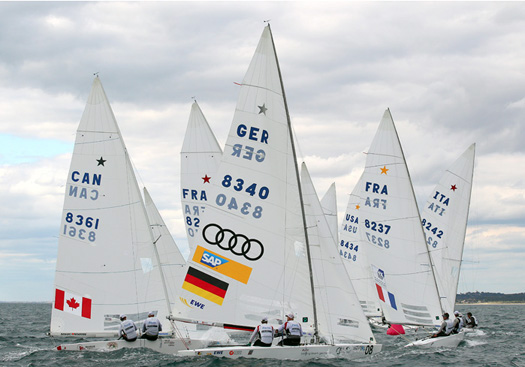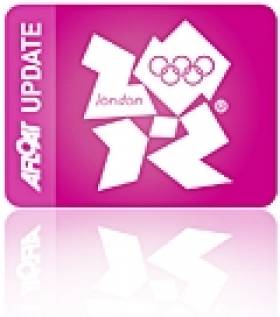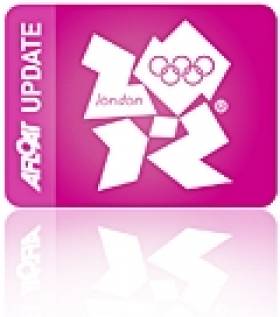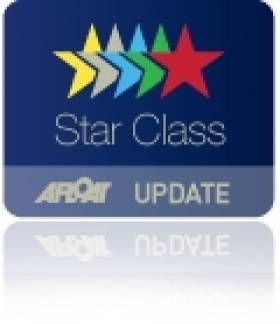Displaying items by tag: Burrows
#etchells – Consistency is king and Bill Hardesty and crew of Stephanie Roble, Taylor Canfield and Marcus Eagan have earned the 2014 Etchells World Championship by sticking to a steady plan for success. Ireland's title bid, that included an eighth place in race three, was cut short after the sole Irish entry in the 90–boat fleet. Howth's Burrows family, sailing Bedrock, only completed the first five of the nine race series in New York. Full results here.
Hardesty's plan was formulated 6 months ago, when he put together his young team consisting of Match Race World Champion Taylor Canfield and top women's match racer Stephanie Roble—25-year-olds eager to dedicate themselves to a worthy goal. Add in top trimmer Marcus Eagan and the team was complete.
After a tough series in Miami last winter, Hardesty made the decision to train in his home waters of San Diego where he had top talent and similar conditions to the worlds venue in Newport. "Tom Carruthers, Vince Brun and Bruce Nelson helped us up our game through sail testing and boat tuning," Hardesty said. But they didn't focus solely on boat speed. "We worked on evaluating risk management to make good decisions, define it, buy into it and follow through; that all came together at this regatta and helped with our consistency."
Hardesty further commented that having three elite match racers on board "gave us an advantage at the start through our time and distance timing and laylines, which made starting easier and more comfortable. We only had one bad start, that was the race we finished 20th."
Commenting on his third Etchells World title, Hardesty said: "This was one of the toughest to win; the level of sailing was at its highest. But it's very exciting. I love the class, I love the boat."
Winning the last race was Peter Duncan, who had local ties. "We didn't sail a particularly great series," said Duncan. "Our expectations were certainly higher, so this was great to end on a high note, which is better than the alternative." Duncan's crew included former world champion Jud Smith and Thomas Blackwell.
Ante Razmilovic, Chris Larson and Stuart Flinn finished second overall, with 2013 world champion Marvin Beckman, Steve Hunt and Ezra Culver in third.
Competitors will look forward to the 2015 Etchells Worlds which will be held in Hong Kong, hosted by the Royal Hong Kong Yacht Club, November 1 to 7, 2015.
Final Top-10 Results
Place, Sail Number, Boat Name, Skipper, Hometown, Race 1, Race 2, Race 3, Race 4, Race 5, Race 6, Race 7, Race 8, Race 9, Total (not including worst score)
1. USA 979, Line Honors, Bill Hardesty, San Diego, 2-2-20-1-4-5-13-15-96/DNC 62.0
2. HKG 1333, Swedish Blue, Ante Razmilovic, London, U.K., 3-6-8-44-14-19-3-31-13 97.0
3, USA 1378, The Martian, Marvin Beckmann, Houston, 8-3-11-5-15-46-32-7-19 100.0
4. USA 1308, KGB, Senet Bischoff & Ben Kinney, Larchmont, N.Y. 10-20-25-52-1-31-2-9-15 113.0
5. USA 1372, Aretas, Skip Dieball, Beaver Dam, Wis., 38-13-4-19-7-17-1-61-23 122.0
6. CAN 1396, Hank Lammens, Norwalk, Conn., 1-8-1-12-16-7-47-49-42 134.0
7. AUS 1383, Triad, John Bertrand, South Yarra, Australia, 4-10-5-28-27-23-53-43-2 142.0
8. USA 1376, Arethusa, Phil Lotz, Newport, R.I., 9-18-6-96/BFD-52-9-12-37-8 151.0
9. USA 1137, La Tormenta, Shannon Bush, Refugio, Texas, 26-16-31-37-6-21-6-16-66 159.0
10. USA 1404, Lifted, Jim Cunningham, San Francisco, 42-4-32-40-50-3-4-25-10 160.0
O'Leary and Burrows Lie Fifth in Hyères
#OLYMPIC SAILING – A 4, 10 and 11 gives Ireland's Star sailors Peter O'Leary and David Burrows fifth overall, six points behind Germany's Johannes Polgar and Markus Koy after three races sailed at the Semaine Olympique Française - Hyères yesterday.
It was a breeze lovers day in Hyères and a long second day on the water for 13 competing Olympic classes.
A point behind The Irish pair in the 25-boat class is Frederick Loof and Max Salminen of Sweden who although counting a 1 and 2 are relegated to sixth with a black flag penalty in the opening race.
Race management issues yesterday forced long delays before the Star's second race yesterday and when it finally did get underway it had to be abandoned due to a drifting windward mark.
Another Irish sailor Dun Laoghaire's Anthony Shanks who is sailing with Britian's John Gimson lie 12th overall.
O'Leary and Burrows, the Irish Olympic pairing who qualified for the London Olympics last December in Perth reiterated their medal aims for Weymouth this summer at a pre-Hyeres interview.
Meanwhile, in the 49er class yesterday Ireland's Ryan Seaton and MattMcGovern, who are also Olympic qualified, counted 14,13,7 in 16-18-knots of breeze and lie 20th from 50 starters.
Ireland's other Olympic qualified sailor Annalise Murphy is not sailing in Hyeres in spite of the presence of some of her arch rivals for Weymouth Evi Van Acker of Belgium and Marit Boumeester of Holland lying third and fourth. Britain's Alison Young is leading the 80-boat fleet.
There are under 100 days to go and nine regattas before the Olympic regatta in July. Irish team officials say they are expecting six medal race finishes and two medals in the run-up to July as a sign that the team is on track to deliver its Weymouth promise of a place on the podium.
Perth Serves up a Tight Finish for O'Leary and Burrows
#PERTH 2011 – Missed opportunities on a crucial day afloat in the Star keelboat means Olympic qualification for Ireland's Peter O'Leary and David Burrows now goes 'to the wire'. Disappointingly, the pair scored a 16th and a 24th today in a fleet of 41 and slip to 15th overall. It follows a black flag result on Tuesday. The top 11 nations will qualify for the Olympics in Perth and although O'Leary/Burrows are in the qualification zone, they will be well aware they occupy the last nation slot. The Cork-Dublin duo have been leapfrogged by the Swiss and now share the same overall score as Spain's Fernando Echavarri and Fernando Rodriquez on 97 points each with only one day of racing left before the medal race on Saturday.

Tight racing in the penulitmate rounds of the Star champs in Perth. Photo: Richard Langdon
The Star class have a rest day tomorrow with their final day of fleet racing taking place on Friday.
Facebook,Twitter Launch for Team O'Leary and Burrows, Website to Follow
The team say they're completing final testing on a new website too. It will be live in the next week or so.

Downwind dazzlers – The Irish Star pair are renowned for their offwind speed
After a string of top results in 2011 the duo are bound for Perth 2012, a regatta where team officials remain confident of a top result.
Follow the Star keelboat duo here on twitter, facebook here and the team website will be here.
Italian Victory, Ireland Fourth at Star European Championships
Another first place in the penultimate race for Italians Diego Negri and Enrico Voltolini sealed their series-long domination and overall victory at the Star European Championship (2nd-10th September) at Dun Laoghaire yesterday. Irish Olympic campaigners Peter O'Leary and Dvid Burrows finished an impressive fourth overall in the 27-boat fleet.
Photos on the Afloat Gallery by Gareth Craig HERE.
Light and shifty conditions followed by a sea breeze completed the regatta that delivered a full range of conditions for the 27-boat fleet from 18 nations.
Negri and Voltolini kept their form for a fourth race win and typically enjoyed a comfortable lead at the finish of race seven. For the crews chasing the runner-up podium positions, the breeze proved as challenging as it has been all week, this time dying to a near calm on the final run before filling gently on the left hand-side side of the course catching the unwary, notably Guillaume Florent and Pascal Rambeau who had been vying with the Italian leaders for first place.
A wait followed for the eighth and final race of the week but only after a long wait for the sea breeze to build and settle. This took the fleet away from the now familiar area off Dun Laoghaire's West Pier and southwards towards this historic Dalkey Island side of Dublin Bay. After starting in ideal conditions of 18 knots, halfway through the race the breeze died completely to be followed by a 90-degree wind-shift that saw 2008 World Champion Mateusz Kusznierewicz and Dominik Zycki emerge with a substantial lead on the water and, having led from the outset were confirmed as second overall runners-up. Negri and Voltolini had already retired as their position was no better than their already discarded eighth in race six and were busy packing their boat as the final ended.
Irish hopes of a podium result on home waters were denied to London 2012 Olympic contenders Peter O'Leary and David Burrows who placed fourth in the last race but a ninth earlier in the day left them fourth overall as Canada's Richard Clarke and Tyler Bjorn took third place.
Star European Championship 2011 at Royal St. George YC, Dun Laoghaire, Ireland
(Final overall after eight races):
1st ITA Diego Negri & Enrico Voltolini
2nd POL Mateusz Kusznierewicz & Dominik Zycki
3rd CAN Richard Clarke & Tyler Bjorn
4th IRL Peter O'Leary & David Burrow
5th NOR Eivind Melleby & Petter Morland Pedersen
6th POR Afonso Domingos & Frederico Melo
O'Leary and Burrows Face Home Waters Test
Olympic keelboat duo Peter O'Leary and David Burrows face one of the sternest tests of the summer season but this time its on waters st least.
All 32 boats for the Star European Championship (2nd-10th September) have arrived in Dun Laoghaire and are busy training on Dublin Bay prior to Sunday's first race. Current world champions and double Olympic Gold medallists Iain Percy (GBR) with Andrew Simpson top the entry list while defending title-holders Johannes Polgar (GER) with Markus Koy are also competing.
Beijing 2008 helm O'Leary along with Olympian Burrows, (who crewed a Star at the Atlanta Olympics in 1996) will be in the hunt for a top three place on home waters while Max Treacy and Anthony Shanks will be competing from their home club for the first Star class event in Ireland.
Percy will be seeking to improve on his second place at the recent London Olympic 2012 test-event at Weymouth while the championship will also be an indicator of form before the ISAF Sailing World Championships at Perth in December.
"This fleet is certainly an example of quality rather than quantity," commented Martin Byrne, Commodore of the Royal St. George YC, organising host club. "Looking at the entry-list, a large number of boats could form a typical world top ten and are capable of winning this championship. We expect Dublin Bay will live up to its reputation as a great racing area and deliver good conditions for the seven races."
Five Star world champions or Olympic medallists are included in the line-up while several more are also former champions in other Olympic classes. Polgar and Koy won last year's championship in Viareggio (Italy) in a record turn-out for the Star class. Second-placed runner-up Andrew Campbell (USA) from 2010 is also in Dun Laoghaire, this time with Ian Coleman and are up against 2009 world champion George Szabo (USA) with Mark Strube in the lead-up to selection for next year's Olympics.
Tornado class Gold medallist Fernando Echavarri (ESP) with Fernando Rodriguez Rivero will be competing along with double world champion and Olympic bronze medallist Xavier Rohart (FRA) and Pierre Alexis Ponsot. Former Finn Gold medallist and 2008 world champions Mateusz Kusznierewicz (POL) and Dominik Zycki are also certain contenders next week.




























































